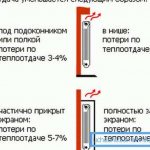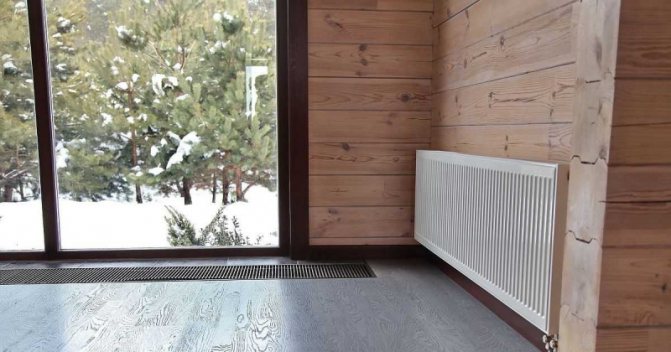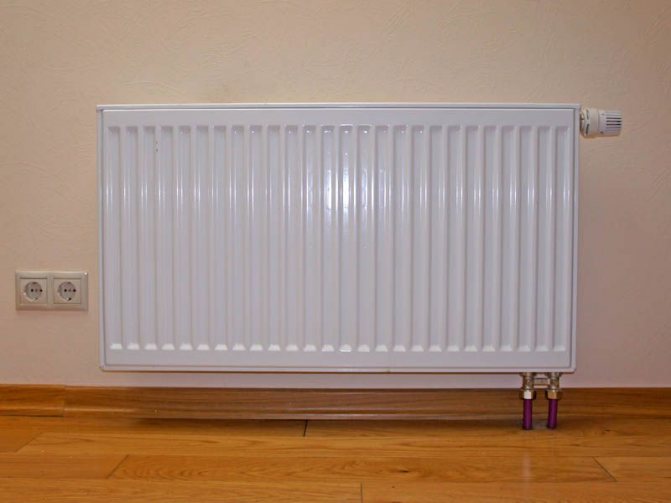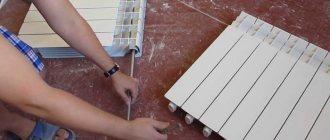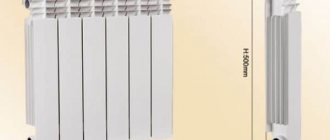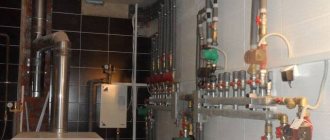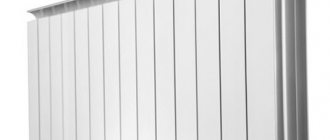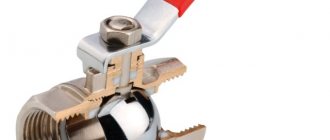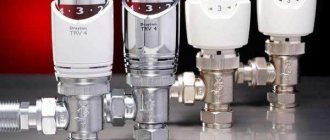Location of heating radiators
The radiator must be installed so that it works with 100% efficiency. The best installation option is under the window. The greatest heat loss in the house occurs through the windows. The location of the heating batteries under the window prevents heat loss and the appearance of condensation on the glass. For large windows, radiators with a height of 30 cm are used, or they are placed directly near the window.
The recommended distance from the floor to the radiator is 5-10 cm, from the radiator to the window sill is 3-5 cm. From the wall to the back surface of the battery is 3-5 cm.If you plan to stick any heat-reflecting material behind the radiator, you can reduce the distance between wall and battery to a minimum (3 cm).
The radiator must be installed strictly at right angles, both horizontally and vertically - any deviation leads to air accumulation, which leads to radiator corrosion.
How to find out the required distance
Many construction work carried out in residential premises is regulated by rules and building codes (SNiPs). There is a SNiP and for the installation of heating batteries.
From it it is possible not only to determine what distance between the radiator and the wall needs to be performed, but also other parameters of its installation:
- position the device under the windows so that the batteries and the centers of the opening coincide,
- the width of the heater should not be more than 70% of the width of the window sill, if any,
- the distance to the floor should not be more than 12 cm, to the windowsill - 5 cm,
- the distance to the wall is within 2-5 cm.
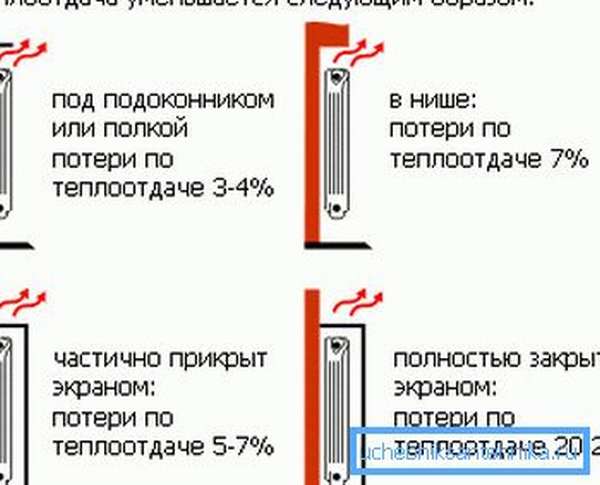
There are a couple of parameters affecting the selection of the optimal clearance. Much more often it is affected by the material of the walls of the house and the size of the window sills. In some rooms, it is possible to notice an unsightly picture, while the batteries substantially maintain its limits.
Note! A large reduction in the gap between the devices of the systems and the heating wall is facilitated by additional surface treatment of vertical structures with special heat-reflecting materials, the price of which is available. These include foil insulation or aluminum foil screens.
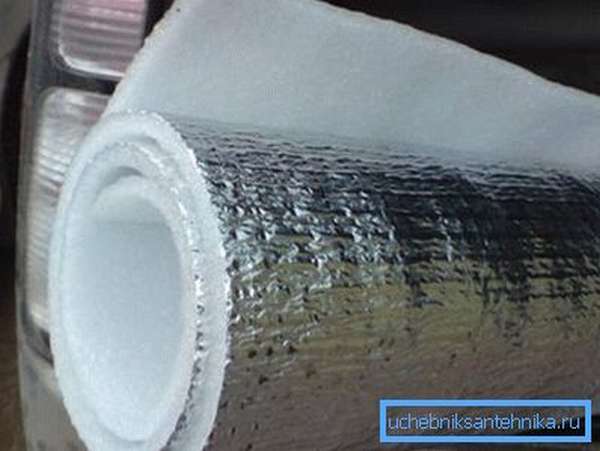

Pipes in the heating system
Advice for those who have central heating in their home. Typically, metal pipes are used for heating systems in apartment buildings.
If the riser pipe in the apartment is metal, you must not switch to polypropylene heating pipes!
In central heating, drops in coolant temperature and pressure often occur - apartment wiring and radiators will fail within a year.
Also, in no case use unreinforced polypropylene pipes - they are designed for operation for water supply and are destroyed at a coolant temperature of + 90 ° C.
Heating radiator fittings
In order for you to be comfortable during the heating season, you need to install thermostats on each radiator. So you can save money by shutting off the batteries in unused rooms and control the temperature in the house. You can purchase programmable thermostats - they will turn off / turn on the radiator, maintaining the required temperature.
Installation of thermostats on each radiator is possible in a two-pipe heating system. In a one-pipe (in apartment and high-rise buildings) system for thermoregulation, a jumper is installed in front of the battery - a bypass. A bypass is a pipe installed perpendicularly between supply and return.The bypass pipe must be of a smaller diameter than the pipes used in the distribution of the heating system.
Also, a Mayevsky valve is installed on the battery - a valve for venting air from the system. These elements simplify radiator control and repair.
Barriers for space heating
The effective heat transfer is also influenced by the barriers that we ourselves create. These include long curtains (70% heat loss), protruding window sills (10%) and decorative grilles. Blackout curtains to the floor prevent air circulation in the room - you simply heat the window and flowers on the windowsill. The same effect, but with lesser consequences, is created by a window sill that completely covers the top of the battery. The thick decorative screen (especially with the top panel) and the placement of the battery in the niche reduce the efficiency of the radiator by 20%.
The window sill not only plays an important role for the window, but can also have an impact when installing batteries, it should be taken into account when choosing curtains. We will consider all the features of choosing the correct height of the window sill from the floor and from the radiator. These installation dimensions are important for the heating system.
Best battery height from floor
All professional builders know that during installation work it is necessary to adhere to certain axiom rules. Some of these postulates are conditional, others are reflected in regulatory documents: GOSTs or SNIPs. Recommendations and rules exist for all details, including the most insignificant ones. Heating devices are no exception to the rule. In this article, we will figure out what is the best height of the battery from the floor.
The principle of placing the heating device
Arranging the heating system cannot be called a simple matter, therefore, you need to choose heating radiators and pipes so that they ideally fit the characteristics of a particular room.
Important! If you are still at the stage of selecting all the components and specify in advance all the technical nuances, according to
Product protrusion functions
The ledge of the sill can be different. There are practically invisible structures that do not stand out behind the window opening, there are also wide, powerful window sills on which you can sit. The structure is needed to retain heat in the house, it can serve as an additional support, for example, for installing flower pots.
The window sill should be chosen carefully, it should be suitable for the window structure, otherwise it may fail. Replacing a part without removing the glass unit is extremely problematic.
Primary requirements
The distance from the floor to the window sill may differ depending on the type of window. However, the GOST provides for the permissible coefficient at which heat is best retained in the room, and the indicator is 0.55 W / ° С × m². This means that in order to achieve the desired effect, you need to use a stove that will have a low thermal conductivity.
An important role is played by the distance of the radiator to the window sill: in that case, there is a SNiP, the main provisions of which require:
Height calculation
The distance between the radiator and the window sill should be at least 10 cm, regardless of what type of heater is used. The height of the battery itself must also be taken into account. Behind it is necessary to retreat 8 cm.The battery itself should rise 10 cm above the floor, that is, when installing the window sill from the floor according to SNIP, you will need to retreat 70-80 cm.
An important role is played by what the ledge of the windowsill will be.
: it may move away from the wall significantly or be invisible. If there is no radiator under the window, it is not necessary to comply with any requirements, but if heating is present, the protrusion must be strictly regulated. The task of the window sill is to redirect heat flows.Without it, they will rise up, and proper heating of the room will not occur, since some of the heat will evaporate and be distributed on the ceiling.
Poor convection can also be caused by a window sill that is too wide. It will not allow warm air to escape, as a result, condensation will begin to accumulate on the window, since the main air flows will go up, and some of them will get stuck under the window, heating the atmosphere. In this case, it is very important to calculate the distance from the window sill to the heating radiator, both in height and how much it is possible to make a protrusion. The problem described above can be avoided by using a slab that does not extend beyond the wall by more than 8 cm.
Advice:
when calculating the dimensions, you need to take into account the level of the wall with decoration.
The best option is a solution in which no more than 10% of warm air will be retained in the window niche. For this, the window sill should not protrude beyond the battery by more than 6 cm, but it should not be shorter than the heater. If the design solution of the room requires the installation of non-standard wide structures, ventilation holes must be provided in them. They must be large enough for proper air circulation.
Do you need a gap?
Some window owners believe that the sill goes deep under the window frame, but this is not the case. The distance between the window and the sill is about 10 mm. Otherwise, the structure may deform. The fact is that under the influence of warm air, the material from which the plate is made expands. A gap is left so that the structure can take the desired shape without being damaged. Visually, this technique is invisible.
How to position the curtain?
The distance of the sill curtain also plays a role. In order for the curtains to move without clinging, there were no traces left on them, and warm air could circulate freely, the distance should be at least 5 cm.
Conclusion: it is not always possible to apply the standard distance from the floor, radiator, curtains to the windowsill, but you can find a way out by observing certain requirements.
The installation of heating devices in private houses in many cases is done by hand, but not all developers know what distance between the wall and the radiator is considered the most optimal. The thermal output of the battery will actually depend on this indicator, therefore, in the course of work, close attention should be paid to this.
Importance of adhering to installation parameters
Heating devices, as their name implies, are installed in a room to heat it. At the same time, for most models of the radiator type, heat radiation is characteristic of the entire surface, which imposes certain restrictions on the installation.
Typically, the distance from the wall to the radiator is 25 to 60 mm. This value is determined, in fact, by two parameters: the fundamental possibility of installation (the size of the window sill, the dimensions of the niche, etc.), as well as the power of the device.
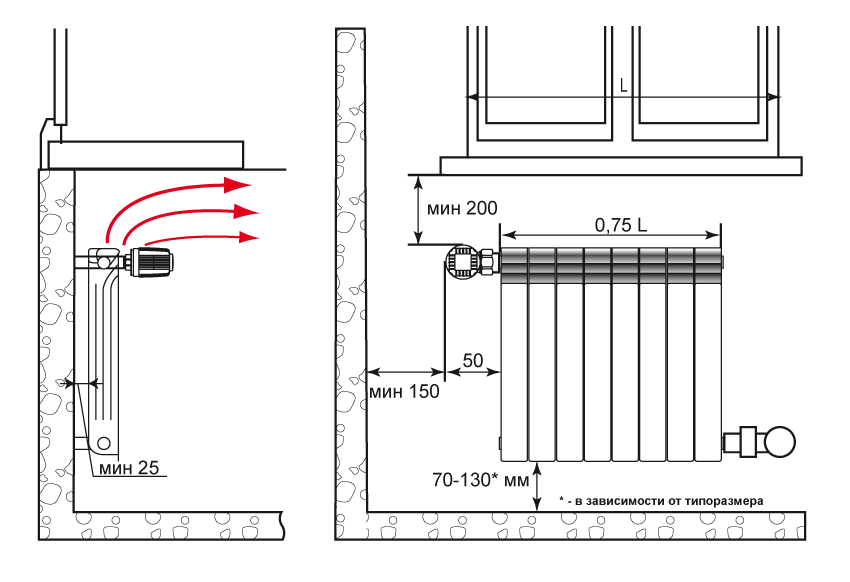

Recommended installation clearances
Note! The more powerful the device and the higher its heat dissipation, the larger the gap between the back surface and the wall should be.
It is not recommended to install the battery close to the wall, and here's why:
- First, for efficient heat exchange between the radiator material and the air, at least a minimum level of circulation must be ensured... In a small gap, the air remains almost motionless, and therefore some of the heat is lost.
- Secondly, in a too narrow space between the rear wall of the radiator and the wall surface, a high temperature is constantly maintained.... Because of this, the level of heat dissipation decreases, the wall of the battery overheats, and the device fails earlier.
Note! This is important for both water radiators and electric heaters. In the former, with constant overheating, corrosion is activated, in the latter, the risk of short circuits increases.


For effective heat transfer, you need to install the device correctly
- Finally, the narrow gap is very quickly clogged with dust, which can be extremely inconvenient to remove during cleaning.... If you leave the dust where it has accumulated, then overheating and problems with heat dissipation will begin to appear rather quickly.
It is on the basis of these considerations that experts decide what distance between the wall and the radiator must be maintained. Well, and how to implement this in practice, we will tell you below.
If the indent is correct
When the heating appliance is in close proximity to a wall, a significant part of the heat radiation is absorbed. Therefore, experts began to think about how far from the wall to hang the radiator in order to improve the efficiency of heating the room.
With an increase in the gap, heat loss decreases, since the side surface heats up less. However, too much indentation will necessarily affect the aesthetic characteristics.
Taking into account the above circumstances, it is recommended to leave a space within 3-5 cm.
- With such a distance, the heat output of heating devices is significantly improved.
- Such a gap makes it possible to clean behind the radiators in a comfortable environment.
- The space from 3 to 5 cm allows you to save usable space without disturbing the aesthetic perception of the structures.
- The radiator of the home heating system will work as efficiently as possible if there is a gap of at least 7 cm from the floor. Thanks to this gap, cleaning the lower part of the room is also easier.
- It is recommended to leave at least 10 cm of free space from the window sill to the appliance. Then the heat losses will be minimal, which means that it will be possible to save on heating the dwelling.
- If the walls of the building are made of materials with a small margin of safety, then it is advisable to install the batteries on the floor using special brackets.
- For maximum efficiency, use a diagonal circuit when connecting to a common system. With this option, the inlet pipeline is connected to the upper part, and the outlet pipeline to the lower one.
- It is not recommended to use decorative screens for heating devices if the level of heat loss of the building is very high. It is also necessary to avoid the device of hidden eyeliner.
- Reflective insulation should not be fixed with small staples or nails, so as not to violate the integrity of the canvas. It is best to use a variety of adhesives that have reliable adhesion to the surface.
- When installing brackets and hooks on a concrete base, anchor plugs must be used. The elements of the system can be mounted to walls and floors made of wood using self-tapping screws.
- If necessary, sections are built up before installation. In this case, a heatsink key is used to connect the modules. There is always a gasket between the component parts.
- Docking of radiators with polypropylene pipelines is carried out with preliminary installation of the coupling. Conductive elements are inserted into it and fixed by soldering.
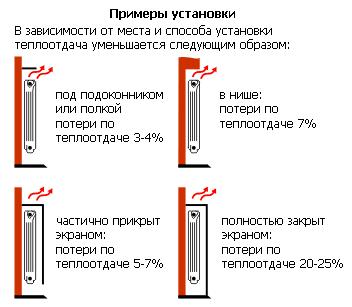

Ensuring a comfortable temperature for people living in a private house or apartment in the winter is a priority task for every owner. When organizing individual heating or heat supply in an apartment building, all elements are important, starting with the distance from the floor to the heating radiator, and ending with the fluid pressure in the system.Before starting work, you should study the building codes and regulations (SNiP) concerning the organization of heat supply, and also find out at what distance experts recommend hanging the heater.
In the living room
How to find batteries for your room
The volume of the batteries should be enough to heat the room
The heating system is a complex structure, therefore, it as a whole and its individual elements, such as heating radiators and pipes, require correct installation and the appropriate selection of a product suitable for a particular room.
Regarding the heating battery, there are recommendations for laying pipelines, the height of the radiators (observing the distances from the floor) and their correct location.
As a rule, radiators are installed in places of greatest heat loss.
As for the choice of the location for the installation of radiators, then, as a rule, these are the places with the greatest heat loss. In almost all houses or apartments, such places are windows and doors, regardless of the use of new technologies. It is not always possible to install a radiator above the door, so they are often mounted under windows.
So that the wall under the window does not become damp, and warm air is evenly distributed over the lower part of the room, and then rises up, it is necessary that the dimensions of the heating radiator make up 70-75% of the window in this room.
A small heater will not produce significant heat dissipation, and there will not be enough heating in the room.
Radiator installation rules
If the radiator is under the window, then install it strictly in the middle.
For heaters, not only is the size a reference requirement, but there are a number of other recommendations that should be followed both when choosing a heating element and when performing installation work.
These requirements include:
- the heating device must be installed strictly in the middle of the window, equally equidistant from the edges;
- the installation height of radiators from the floor should not exceed 15 cm, otherwise cold zones will form above the floor, and if the heater is lowered below 8-10 cm from the floor, then cleaning under such a device will be problematic;
- radiators should stand at a distance of 12-18 cm from the window sill; if the device is placed closer, then there may be a loss of heater power due to the influx of cold air from the window opening;
- the distance from the back of the device to the wall covering should be 3-7 cm, this is necessary for correct air convection.
It should be remembered that if the radiator is as close to the wall as possible, then the gap will be a "dust collector", and besides, the device during the heating period can not only spoil the outer wall decoration (wallpaper), but also destroy the wall structure - a plasterboard.
Standards
SNiP standards are advisory in nature, but when replacing batteries in an apartment of an apartment building with a central heating system, their implementation is mandatory. This is due to the fact that when designing the house, all the conditions for its further maintenance were taken into account and, among other things, economical heat supply.
According to established standards in a brick or panel house, the following is provided:
- The distance from the floor to the radiator or radiator should be within 80–140 mm. A lower installation height will make it impossible to carry out wet cleaning under the device, provoke the accumulation of dust undesirable for human health, a large installation will reduce the useful heating zone.
- The distance between the battery and the windowsills should be 100–120 mm. If the distance from the radiator to the window sill is reduced, the conversion of air masses will decrease and the efficiency of the radiator will decrease.
- Installation of heating radiators from the wall by more than 30-50 mm is not recommended due to the fact that, as in the previous case, the conversion decreases, as well as provokes the accumulation of dirt with minimal possibilities for its elimination.
It is necessary to hang the radiator above the floor exactly in the center of the window opening.
This will ensure the creation of a heat shield in the area of the glass filling of the window, while maintaining the aesthetic appearance of the room.
Installation technique
Wall option
When doing installation work with your own hands, it is much easier to fix the battery on the wall. This task is less time consuming compared to floor installation, but all operations must be performed very efficiently.
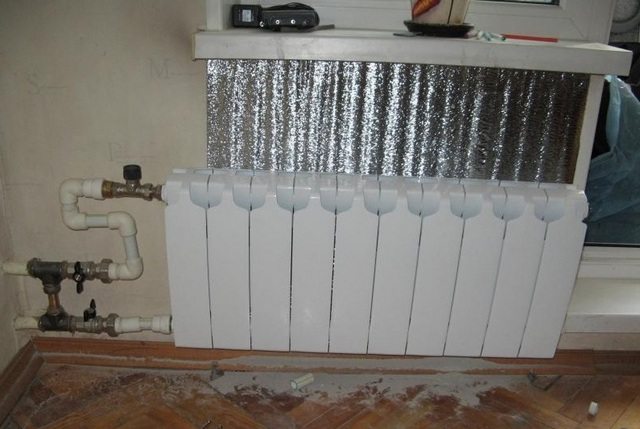

Photo of a foil-clad thermal insulation layer behind the heating device
The installation process itself includes the following stages:
| Stage of work | Operations performed |
| Site preparation |
|
| Markup | We apply markings on the surface for installing the battery (in principle, this must be taken into account when buying a radiator, but duplication will not be superfluous here either):
|
| Installing fasteners |
|
| Installing the radiator |
|
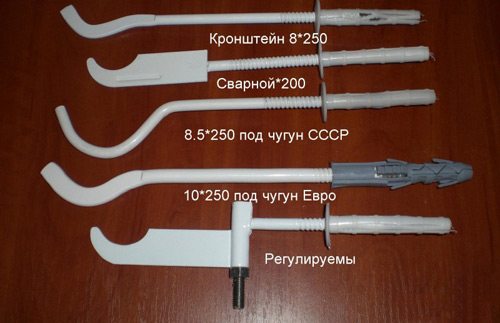

Most commonly used brackets
As you can see, the instructions are not complicated, but you need to control the quality of work at every stage.
Floor option
Sometimes the battery turns out to be too heavy to hang it on the wall - there is a risk that the material simply will not withstand. In this case, the installation is carried out using the floor brackets. Yes, the price of such products will be slightly higher than that of wall mounts, however, the safety margin is incomparable.


Floor bracket drawing with wiring diagram
The installation process itself involves the following actions:
- We select a pair of brackets that have sufficient bearing capacity to support the weight of the battery.
- We install racks on the base of the floor, which we fix with anchors. We select the distance from the wall in such a way that the minimum gap between it and the mounted radiator is 60 mm.
Advice! It is better to mount the floor brackets before pouring the screed - this way we can mask the attachment point.
- We fill the tie, hiding the bases of the brackets and the heads of the fastening anchors.
- We put on hooks on the racks, which we set to the desired height and fix with bolts. If the complete set of the product provides for this, we install metal gaskets that will protect the radiator material at the point of contact with the hook.
- We hang the radiator on the hooks, which we then carefully align.
Product photos
Despite the great complexity of implementation, this system has obvious advantages: the load from the battery is not transferred to the wall, but to the floor, so that the risk of loosening the fasteners will be minimal.
Connection diagrams
Several schemes for connecting radiators into a single thermal system have been developed and are used. They are represented by the following types:
- the maximum heat output occurs with side connection, which involves mounting the input in the upper sector of the battery, the output is at the bottom on the same side;
- with a significant size of the heat sink, a diagonal connection is considered the best option, where water enters through the upper pipe and is discharged from the bottom, from the opposite side;
- when installing hot water supply pipes hidden under the floor surface, a circuit with a bottom connection, popularly called "Leningradka", is used.
Bottom wiring
If the heat supply pipes are placed in a rough screed, then significant heat losses should be expected due to contact with concrete and the ceiling of the lower floor.
Types of heating batteries
The efficiency of heating the room will depend not only on how far from the floor to hang the battery or heating radiator, but also on the connection diagram, material and device of the heating devices themselves. The following models are on the market today:
- Cast iron batteries. The adult generation probably knows them firsthand. During the Soviet Union, only these models were used in heating systems. Today they have a more presentable appearance. They are characterized by a high level of heat capacity, long-term heat release, lack of consequences during hydraulic shocks, and they also have an increased service life.
- Steel radiators. They have low heat transfer rates - heating occurs quickly, but they cool down no less quickly. The welded construction is sensitive to water hammer. There is no way to add sections yourself. However, the weight of the product and the ease of installation attract many homeowners. The goods of the German trade mark "Kermi" are in special demand.
- Aluminum radiators. They are characterized by low weight, beautiful shape, and increased heat output. They are presented on the market in two versions, where in the first the structure consists of one monoblock, with a volume that provides different powers, in the second - a type-setting sectional.
- Bimetallic batteries. The innovative design of the placement of heating collectors made it possible to achieve the level of heat transfer of aluminum models, as well as the strength and reliability of cast iron counterparts.
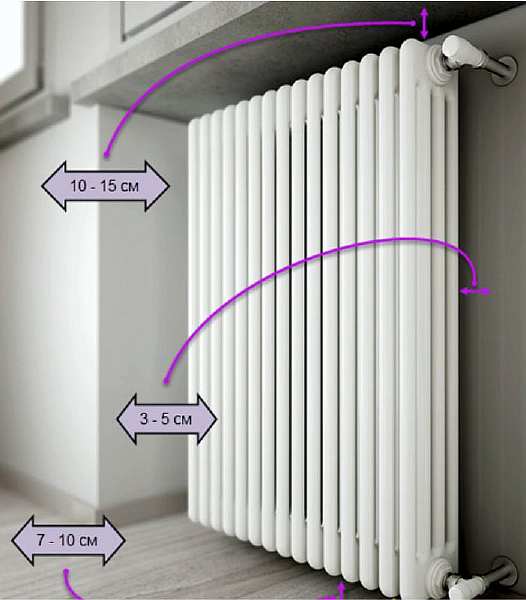

Minimum clearances
The purchased radiators must meet the GOST standards. Compliance is checked by reviewing the documents for the product in the store. Their absence may serve as a reason for refusing to purchase a product at this outlet.
Radiator installation rules
When replacing batteries throughout the house or apartment, it is important that the installation diagram of heating radiators is left and agreed with the appropriate specialists. It serves not only as a guideline when performing installation work, but also, if drawn up correctly, will allow you to heat the room more efficiently, allowing the customer to save money.
Cut off the water in the apartment, and then at a specific site.
Drain water from the area to be replaced.
Blow out the pipes and etch out the remaining water.
Dismantle the old radiator.
Install a new radiator, focusing on the installation instructions, as well as recommendations from the manufacturer (instructions for installing a certain type of radiator must be included with the certified product).
After completion of installation and pressure testing, the system is tested for leaks and operation of the radiator sections.
IMPORTANT! When choosing a radiator, consider: the maximum heating temperature;
- the maximum area for normal heating of which a certain number of radiator sections can be used;
- working pressure of this coolant; pressure indicator for crimping the system.
Installation of radiators: SNiP
Installation of heating - radiators for heating the room - must be carried out in accordance with SNiP 3.05.01-85.
General rules for installing heating radiators according to SNiP
- The norms for installing heating radiators assume that the battery is mounted relative to the center of the window: so that it coincides with the center of the battery (in this case, the error should not exceed 2 cm).
- Installation rules also suggest that the width of the radiator should be 50-75% of the width of the window sill.
- The height of the battery installation above the floor should not exceed 12 cm from the level of the finished floor to the lower edge of the radiator. The distance between the upper panel of the radiator and the window sill should not be less than 5 cm.
- The distance from the wall to the radiator should be 2 to 5 cm. In some cases, the wall surface must be covered with a special heat-reflecting material before installing the radiator.
IMPORTANT! You cannot place the radiator too low or close to the wall - this will significantly affect the heat transfer rates, and also simply make it difficult to clean under and behind the radiator.
IMPORTANT! When installing radiators in one-pipe heating systems, the use of more sections than was previously used is prohibited. When installing radiators in systems with artificial water circulation, if the number of sections is 24 or more, it is recommended to use a versatile method of connecting heating devices.
Installation of aluminum radiators
The procedure for installing aluminum radiators with your own hands:
Assemble the radiator by screwing in the radiator plugs, as well as the plug with gaskets and installing the thermostatic valve, Mayevsky valve and shutoff valves.
Guided by the above general rules for the location of the radiator relative to the window, mark the installation locations of the mounts.
If necessary, cover the surface of the wall with heat-reflecting material and fix the brackets to the wall (be sure to use a level to determine the horizontal, as well as a tape measure to determine the length of the bracket's entry into the wall).
Fasten the radiator to the brackets by placing their hooks between the battery sections. Connect the radiator with a centralized or autonomous space heating system according to the selected connection diagram.
Installation of aluminum radiators can be carried out both in one- and two-pipe heating systems with horizontal or vertical piping. These radiators can also be used for space heating with natural and forced circulation of hot water. Today the market can offer two options for aluminum radiators:
- Reinforced radiators with working pressure up to 16 atm. Such batteries are used for heating high-rise residential and non-residential buildings. For heating a private house, the use of this type of radiator is unjustified due to the high cost of the sections.
- European type of aluminum radiators designed for space heating with autonomous heating systems. The maximum working pressure in such radiators is no more than 6 atm.
The installation kit for aluminum radiators consists of:
- an automatic or manual air release valve (the so-called Mayevsky valve);
- plugs (right-hand or left-hand thread);
- sealing gaskets;
- racks or brackets;
- shut-off or thermostatic valves.
Installation of cast iron radiators
Installation of cast iron radiators procedurally does not differ from the installation of aluminum heating devices. In the case of cast iron products, it is important, however, not to overload the wall, and also pay more attention to the dynamometric moments. Cast iron radiators are recommended to be installed at a slight slope so that hot air does not accumulate inside the radiator (this can lead to a decrease in the heat transfer of the device).
Cast iron radiators also have a different assembly system: before installing such a radiator, you need to unscrew, tighten the nipples and reassemble the radiator together. floor stands. In this case, wall mountings are also performed, however, they perform only a supporting function.
Installation of bimetallic radiators
The advantages of installing bimetallic radiators, rather than cast iron or aluminum, are that they weigh relatively little and, provided that they are not inferior in terms of heat transfer to aluminum, bimetallic radiators are able to operate smoothly even at high pressure in the system. The installation method, as well as general recommendations for installing such heating devices, are indicated in the instructions for the product.
IMPORTANT! Pay attention to the manufacturer's recommendations regarding the use of pipes made of a particular material in combination with bimetallic radiators. So, for example, for most houses, only metal pipes are provided, and metal-plastic can only be installed in private houses, whose heating system operates at high pressure.
Installation of radiators
Installation of all types of heating radiators is carried out using the same technology. The difference is represented only by the selected connection scheme and the need to purchase plugs of a larger diameter for cast-iron batteries than for other types, as well as to install an air vent on them, and not a Mayevsky crane.
In the bedroom
Tools and accessories
Installation of heating elements is accompanied by the use of the following:
- a set of locksmith tools;
- drill or hammer drill with a set of drills;
- hammer;
- screwdriver or screwdriver;
- accessories for measuring and marking;
- building level and corner.
Purchase the following components and accessories:
- Radiators with a set of brackets or holders.
- Mayevsky's cranes, which meet the requirements of GOST, are better than domestic or European production. Others can be difficult to attach to the radiator.
- Fasteners for fittings and pipes.
- Plugs, taking into account the installation of one Mayevsky crane per battery.
- Shut-off valves for prompt shutdown of a failed heating element from the system for replacement.
Under window
Installation of faucets with smooth heat regulation on each battery will significantly save energy consumption and create a comfortable atmosphere in rooms for different purposes. Cranes are either mechanical or electronic.
Premises preparation
Before starting the installation work, it is necessary to prepare the room. If you plan to connect according to the "Leningradka" scheme, then you should dismantle the floor coverings in the rooms. In other cases, this is optional.
So that the furniture does not interfere with the dismantling of old heating elements and the installation of new radiators, it is removed to the center of the room. Prepare accessories for collecting water residues from removable batteries, as well as putting things in order at the place of their attachment.
DIY installation
After preparing the tool, accessories and premises, they begin to engage in installation. The works are performed in the following sequence:
- Make a markup. To do this, use a building level and a tape measure. Measure the height of the heating element, add the distance of the radiator from the floor, make a mark on the wall. Using the level, draw a strictly horizontal line along the mark. The installation points of the holders retreat from this line and fix on the plane of the wall.
- Drills for dowels are made using an electric drill or hammer drill. Keeping the distance from the battery to the window sill, the holders are screwed in. Recheck the horizontal.
- Unpacking the radiator.The device is sold in a protective film. If the installation is carried out during the construction period, it is not recommended to remove it until the end of the work. Under circumstances when it is necessary, for example, to hang it in the kitchen to replace the old one, the film is removed before installation.
- Heating element layout. A mechanical or automatic air release device is being installed. It is screwed into a seat in one of the upper collectors, opposite the hot water input. Plugs are screwed onto unused outputs. If there is a difference in diameter, special adapters should be used.
- Ball valves are installed at the inlet and outlet. They provide the ability to dismantle an individual heating element without interrupting the operation of the entire system.
- After assembling all the components of the thermal element, it is carefully hung on the brackets. Check the accuracy of keeping the distances in accordance with the requirements of SNiP 2.04.05-91.
- Connect the inlet and outlet pipes. Their fixation depends on the type of connection used - threaded, by crimping or pressing.
Distance from the floor and wall in accordance with SNiP standards
At the first start-up of the battery, water is supplied under low pressure, ensuring smooth filling of the cavities.
Abrupt activation of the system can result in a water hammer that will damage the housing or destroy the inlet valves.
If you are already registered, enter your login information!
Previous article Next article
Installation rules for heating radiators
A heating system should be present in every home. At the same time, it is extremely important that at each stage of its installation all the rules for installing heating radiators are strictly observed - violations of any of them can lead to serious disruptions in the operation of the system and even lead to damage to the equipment.


Installing the control radiator
POSSIBLE RADIATOR CONNECTION DIAGRAMS
Before proceeding with the installation of heating radiators, it is extremely important to determine the connection diagram. There are several options for how to do this, this is indicated in the snippet. Each of them has both certain advantages and disadvantages. Connection methods:
- side connection... This method is, perhaps, the most common, since it is he who allows you to achieve maximum heat transfer from radiators. The installation principle is quite simple - the supply pipe is connected to the upper radiator pipe, and the outlet pipe is connected to the lower one. Thus, both the inlet and outlet pipes are located at one end of the battery.
- diagonal connection... This method is used mainly for long radiators, since it allows you to achieve maximum heating of the battery along the entire length. In this case, the inlet pipe should be connected to the upper branch pipe, and the outlet pipe to the lower one, which is located on the other side of the battery.
- bottom connection... The least efficient connection method (compared to the lateral method, the efficiency is 5-15% lower), used mainly for heating systems located under the floor.
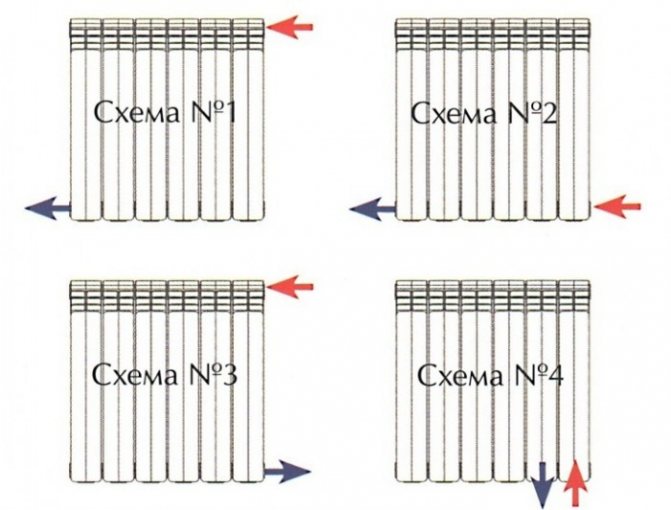

Heating radiator connection options
INSTALLATION INSTRUCTIONS FOR HEATING RADIATORS
So, how to properly hang radiators? You have purchased radiators and even decided in which way they will be installed. Now you need to get acquainted with all the requirements of the SNIP - and you can proceed with the installation. It's actually pretty simple.
Most radiator manufacturers, trying to make the life of users as easy as possible, attach detailed instructions and rules for installing heating radiators with each battery.
And they really need to be followed - after all, if the radiator is installed incorrectly, in the event of a breakdown, repairs under warranty will be denied.


Heating radiator installation diagram
If you want to protect the device from scratches, dust and other damage that may occur during installation, then during the installation process you can not remove the protective film - this is allowed by the rules for installing heating batteries. The single most important requirement that must be followed strictly is the strict observance of the indents necessary for normal circulation of heated air. Here are the rules for installing heating radiators to the indents that SNIP puts forward:
- according to the current regulations, the distance from the window sill or the bottom of the niche should be at least 10 cm. It should be borne in mind that if the gap between the radiator and the wall is less than ¾ of the battery depth, the flow of warm air will get into the room much worse.
- the same strict requirements are put forward for the installation height of the radiators. How to place the radiators correctly? So, if the distance between the lower point of the radiator and the floor level is less than 10 cm, then the outflow of warm air will be difficult - and this will negatively affect the degree of warming up of the room. The ideal distance is 12 cm between the floor and the radiator. And if this gap is more than 15 cm, then there will be too much temperature difference between the upper and lower parts of the room.
- if the radiator is installed not in a niche under a window, but near a wall, then the distance between the surfaces should be at least 20 cm.If it is less, then air circulation will be impeded, and in addition, dust will accumulate on the rear wall of the radiator.


Installing heating radiators against the wall
In order to get the maximum of useful information regarding the installation of radiators, you can use our resource. You can find many valuable tips and advice on how to properly install a heating radiator.
HEATING RADIATOR INSTALLATION PROCEDURE
It should be noted that the SNIP also contains the procedure for installing a radiator. Using it, you can do everything correctly:
- First of all, you need to determine the location for the fasteners. Their number depends on the size of the battery, but even in the case of installing the smallest radiator, there should be at least three brackets;
- The brackets are attached. For reliability, you must use dowels or cement mortar;
- The necessary adapters, Mayevsky crane, plugs are installed;
- Now you can start installing the radiator itself;
- The next step is to connect the radiator to the inlet and outlet pipes of the system;
- Next, you need to install an air vent. According to modern SNIP, it must be automatic;
- After the correct installation of heating radiators is completely completed, you can remove the protective film from the radiators.
If, during the installation of heating radiators, you adhere to all the above rules and requirements, then in this case you will enjoy the warmth for a long time, which is provided by your correct installation of radiators and a well-made heating system.
Previous article Next article
